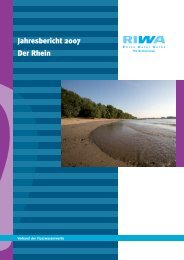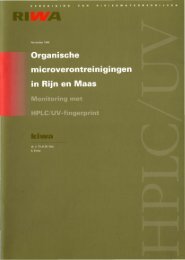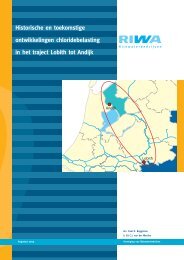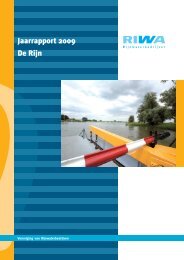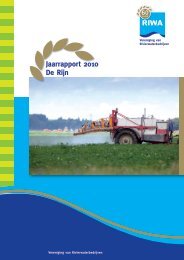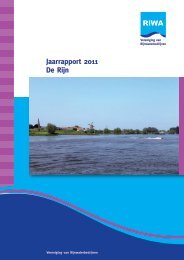Organic micropollutants in Rhine and Meuse a - Riwa
Organic micropollutants in Rhine and Meuse a - Riwa
Organic micropollutants in Rhine and Meuse a - Riwa
You also want an ePaper? Increase the reach of your titles
YUMPU automatically turns print PDFs into web optimized ePapers that Google loves.
1<br />
INTRODUCTION<br />
In the framework of the regular research done by RIWA <strong>in</strong>to the quality of the Rh<strong>in</strong>e<br />
<strong>and</strong> <strong>Meuse</strong>, these rivers are exam<strong>in</strong>ed monthly for a large number of chemical<br />
compounds. These are identified pollutants whose presence <strong>in</strong> the surface water,<br />
which is used for dr<strong>in</strong>k<strong>in</strong>g water production, is considered undesirable. In total, about<br />
100 substances are <strong>in</strong>volved, 50 of which are pesticides. In research done to ascerta<strong>in</strong><br />
the organic substances present <strong>in</strong> the Rh<strong>in</strong>e <strong>and</strong> <strong>Meuse</strong>, it was established that<br />
hundreds or even thous<strong>and</strong>s of substances can occur, of which several are highly<br />
undesirable from a health po<strong>in</strong>t of view (Van Genderen, Noij <strong>and</strong> Van Leerdam,<br />
1994). The costs alone make it impossible to monitor all these substances with<br />
adequate frequency. In addition, many pollutants are not permanently present, <strong>and</strong><br />
some are <strong>in</strong>deed present only <strong>in</strong>frequently (<strong>in</strong> the case of accidents). This means that if<br />
extensive monitor<strong>in</strong>g programmes, <strong>in</strong> which hundreds of substances are tested for,<br />
were <strong>in</strong> place, the analysis results for the majority of the substances would be<br />
negative. For this reason, there is a need for a cost-effective method of obta<strong>in</strong><strong>in</strong>g nonspecific<br />
<strong>in</strong>formation on the overall water quality, which allows immediate, targeted<br />
action to be taken (such as stoppage of <strong>in</strong>take, mix<strong>in</strong>g with water of other qualities, or<br />
adaptation of the treatment conditions), should a limit value be exceeded. Biological<br />
monitor<strong>in</strong>g systems which measure an overall effect of the water quality (fish<br />
monitor<strong>in</strong>g, mussel monitor<strong>in</strong>g, microtox monitor<strong>in</strong>g) are currently receiv<strong>in</strong>g<br />
considerable attention.<br />
In addition to biomonitor<strong>in</strong>g, chemical monitor<strong>in</strong>g is still very important. The<br />
challenge now is to obta<strong>in</strong> as complete as possible a picture of the water quality by the<br />
simplest <strong>and</strong> cheapest possible means. On the basis of laboratory methods for polar<br />
pesticides, an HPLC method has been developed which <strong>in</strong>dicates the presence of a<br />
broad range of organic substances, without it be<strong>in</strong>g necessary to know exactly which<br />
substance is which ("f<strong>in</strong>gerpr<strong>in</strong>t"). In a study commissioned by the Foundation for<br />
Applied Water Management Research (STOWA), the HPLC f<strong>in</strong>gerpr<strong>in</strong>t was evaluated<br />
<strong>and</strong> applied to various surface water samples (STOWA, 1997). This f<strong>in</strong>gerpr<strong>in</strong>t<br />
method is suitable for polar <strong>and</strong> weakly polar substances, can be used for monitor<strong>in</strong>g<br />
of changes <strong>in</strong> concentration of identified <strong>and</strong> unidentified substances as a function of<br />
location (<strong>in</strong> the direction of flow), <strong>and</strong> proved to be capable of reliably measur<strong>in</strong>g low<br />
concentrations of identified substances (pesticides). In addition, with this method, it<br />
was possible also to establish the content <strong>and</strong> type of natural organic material<br />
("humus") present.<br />
In the present study, which was commissioned by RIWA (reference 6/1:25138), the<br />
quality of the Rh<strong>in</strong>e <strong>and</strong> the <strong>Meuse</strong> was exam<strong>in</strong>ed by this "HPLC f<strong>in</strong>gerpr<strong>in</strong>t" method.<br />
With this method, it is possible to obta<strong>in</strong> a picture of the overall water quality with<br />
reference to polar <strong>and</strong> weakly polar organic compounds. While the project was<br />
underway, a number of water companies (DZH, GWA, PWN, WBBIWBE, WRK <strong>and</strong><br />
WZHO) decided to use the HPLC f<strong>in</strong>gerpr<strong>in</strong>t for monitor<strong>in</strong>g the effects of treatment<br />
processes on the quality of the Rh<strong>in</strong>e <strong>and</strong> the <strong>Meuse</strong>. The research will be reported on<br />
separately to the companies concerned, use be<strong>in</strong>g made of the results of the RIWA<br />
study.<br />
In the framework of the Water Companies Jo<strong>in</strong>t Research Programme, Kiwa is<br />
currently carry<strong>in</strong>g out research <strong>in</strong>to improvement of the HPLC f<strong>in</strong>gerpr<strong>in</strong>t method.<br />
This improvement relates <strong>in</strong> particular to the isolation method <strong>and</strong> enables better<br />
6<br />
RIIIN'A



